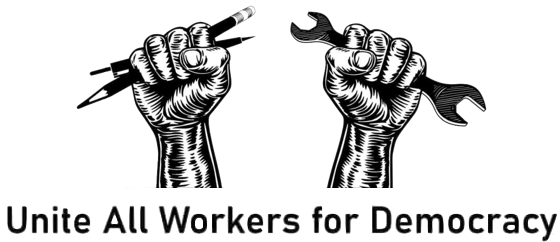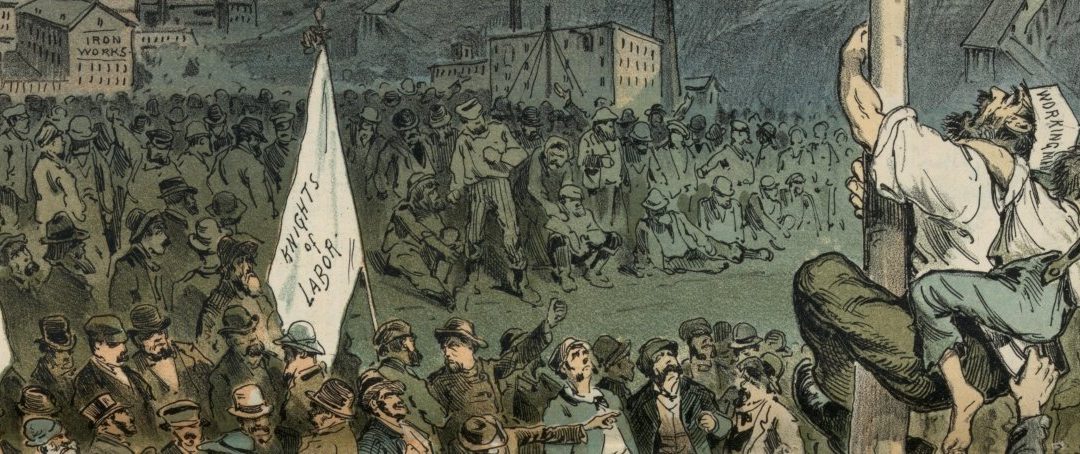Follow Erik Loomis on Twitter
Read Erik Loomis’ work on Lawyers, Guns, & Money
Historian Erik Loomis on This Day in Labor History: August 13, 1887. Leathermakers in Newark, New Jersey, locked out their employees as a strategy to crush the Knights of Labor. Let’s talk about how American employers have always been exceptionally anti-union.
Newark had become a major industrial center by the 1880s and, unlike many cities, hosted a wide number of industries. One of the largest was the leather industry. This was exceedingly odious labor.
As a noxious industry, leather production was banished to the outskirts of cities going back to colonial New England. Two centuries of technological advancement had not significantly decreased the odiousness of this work.
By the late nineteenth century, as was happening with laborers around the country, skilled workers were increasingly replaced by unskilled, often immigrant labor, laboring in mass-scale industrial operations.
Newark was also a strong union town and a Knights of Labor local began there in 1879, as the Panic of 1873 subsided. The leather workers do not seem to have been involved in its early days. The first specifically leather-based Knights hall opened in 1883.
After 1884, the Knights grew rapidly in Newark, as they did throughout the country. Strikes abounded. More than twice as many strikes took place in Newark in 1886 than did between 1881 and 1885.
Half of the strikes were over employers backsliding from agreements they had made to stop earlier strikes. Leather workers struck over other issues, including an end to piecework and for higher wages.
As 1886 turned into 1887, the leatherworkers — skilled and unskilled and often in different Knights’ lodges — began to coordinate their strikes more effectively. Solidarity and a more concrete sense of class identity was building. This was important.
It took time for the ideology of free labor republicanism to wear off in the face of endless drudgery and exploitation. Workers didn’t see themselves as that different from employers in the first twenty years after the Civil War. Slowly that began to change.
The growth of the Knights was far from what Terence Powderly had envisioned and the growing direct action tactics of many lodges demonstrated that this ideological commitment to free labor had started to fade by the mid-1880s.
This hardly meant that these Knights were radicals. It took time to give up old conceits. Despite the famous connections between Knights’ actions and the Haymarket Riot in 1886, the Knights had very little tolerance for radicals, and not only at the top.
Newark Knights repeatedly stated the conservative nature of their actions. They largely believed in the American Dream and respected the small employers who had risen out of the working class. They saw a big difference between that person and John D. Rockefeller or Jay Gould.
By 1887, the Knights had begun to decline. In part this was about the backlash to Haymarket and in part it was due to divisions both within the Knights and between the Knights and other labor unions. The Knights really weren’t constructed to be a mass movement.
But masses of workers around the nation still held to their Knights membership. Sensing weakness, the leather manufacturers banded together and struck back. The initial issue was that in June, they had agreed that workers could only tan a limit of forty hides in a day.
They resented giving up any control over the shopfloor, which the agreement had also allowed. The manufacturers began to coordinate with each other. They selected one to violate the agreement, knowing workers would strike.
When this happened, the employer imported strikebreakers while the other employers took over his orders and worked them in employer solidarity. The Knights lost.
This set the stage for the August lockout, where the leather owners sought to eliminate the Knights entirely.
Given the cutthroat nature of American business competition(a scenario that would continue until the New Deal), it was almost as hard to get employers to cooperate as it was for workers to try and unionize.
But the success in freeing one factory from the union convinced many skeptical owners to join the employers association.
The bosses announced the lockout for August 1, but waited until August 13 as rhetoric rose between the two sides and the Knights debated on whether they should strike first. But the workers simply didn’t have the resources of the bosses, even pooled together as a union.
Knights’ dues were very low and though the union said it could stay out for 3 months, it ran out of money almost immediately.
The Knights tried to appeal to the small manufacturers in terms of the working-class and small employer solidarity at the heart of free labor ideology, but not a single one failed to honor the lockout. By the third week, the situation grew desperate.
Internal tensions between the more radical German members and more conservative English and Irish members and rapidly dwindling funds destroyed the Knights. A few went back to their old jobs but most were not rehired.
Shop stewards were blacklisted and many had to move from Newark to find work. The Knights were dead in the leather industry. Unions in Newark were pushed back significantly. At the start of 1887, there were 48 workers associations in the city. By the end of 1888, there were 12.
Ultimately, the Knights failed in Newark because employers would do anything to crush them. And this has been the primary problem of American unionism.
It took remarkable government action during an unprecedented economic crisis to change this scenario in the New Deal and employers have resented it ever since.
That is the fundamental problem organized labor has today. It’s not bad union leadership, a lack of union democracy, not enough organizing, or the other reasons union supporters and those who critique unions from the left usually provide.
These are small factors, but the fundamental issue is that American employers will stop at nothing to eradicate unions.
And that’s a very different circumstance than either Britain and France during the 1880s, or Germany today, where employers and unions routinely work together on management decisions, up to the point of encouraging unionization of the Volkswagen plant in Chattanooga, Tennessee.
That workers in that Chattanooga VW plant still rejected the union after local opposition shows the tremendous power of the American workplace structure in rejecting unions.
It’s not just that American employers don’t like unions–it’s that compared to European nations, they have an exceptional opposition to unionization. It’s a real problem!
This thread is based on Kim Voss, The Making of American Exceptionalism: The Knights of Labor and Class Formation in the Nineteenth Century. This is critical reading because it provides the direct comparison to employers in England and France I allude to.

